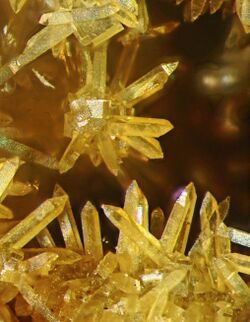Chemistry:Thomsenolite
From HandWiki
| Thomsenolite | |
|---|---|
 Thomsenolite (obelisks) and some pseudocubic ralstonite (picture center) | |
| General | |
| Category | Halide minerals |
| Formula (repeating unit) | NaCaAlF6·H2O |
| Strunz classification | 3.CB.40 |
| Crystal system | Monoclinic |
| Crystal class | Prismatic (2/m) (same H-M symbol) |
| Space group | P21/b |
| Identification | |
| Color | Colourless, white, pale lilac; brownish or reddish tinted due to staining; colourless in transmitted light. |
| Cleavage | Perfect On {001}; {110} distinct. |
| Fracture | Irregular/ uneven |
| Tenacity | Brittle |
| Mohs scale hardness | 2 |
| Vitreous, pearly|re|er}} | Vitreous, pearly |
| Streak | White |
| Diaphaneity | Transparent, translucent |
| Density | 2.981 g/cm3 |
Thomsenolite is a mineral with formula: NaCaAlF6·H2O. It is an alteration product of cryolite.[2]
It was discovered in 1868 in Ivigtut, Greenland and named for Hans Peter Jorgen Julius Thomsen (1826–1909).[3]
References
- ↑ Warr, L.N. (2021). "IMA–CNMNC approved mineral symbols". Mineralogical Magazine 85 (3): 291–320. doi:10.1180/mgm.2021.43. Bibcode: 2021MinM...85..291W.
- ↑ "Handbook of Mineralogy". http://www.handbookofmineralogy.com/pdfs/thomsenolite.pdf.
- ↑ Mindat.org entry
 |

